+ Open data
Open data
- Basic information
Basic information
| Entry | Database: PDB / ID: 2nln | ||||||
|---|---|---|---|---|---|---|---|
| Title | Solution Structure of Calcium-free Rat Beta-parvalbumin | ||||||
 Components Components | Oncomodulin | ||||||
 Keywords Keywords | METAL BINDING PROTEIN / CALCIUM-BINDING PROTEIN / RAT BETA PARVALBUMIN / RAT ONCOMODULIN | ||||||
| Function / homology |  Function and homology information Function and homology informationcuticular plate / stereocilium / supramolecular fiber / cochlea development / response to wounding / vesicle / calcium ion binding / protein-containing complex binding / protein homodimerization activity / protein-containing complex ...cuticular plate / stereocilium / supramolecular fiber / cochlea development / response to wounding / vesicle / calcium ion binding / protein-containing complex binding / protein homodimerization activity / protein-containing complex / extracellular space / identical protein binding / cytoplasm Similarity search - Function | ||||||
| Biological species |  | ||||||
| Method | SOLUTION NMR / simulated annealing using torsion angle molecular dynamics | ||||||
 Authors Authors | Henzl, M.T. | ||||||
 Citation Citation |  Journal: Protein Sci. / Year: 2007 Journal: Protein Sci. / Year: 2007Title: Solution structure of Ca2+-free rat beta-parvalbumin (oncomodulin). Authors: Henzl, M.T. / Tanner, J.J. | ||||||
| History |
|
- Structure visualization
Structure visualization
| Structure viewer | Molecule:  Molmil Molmil Jmol/JSmol Jmol/JSmol |
|---|
- Downloads & links
Downloads & links
- Download
Download
| PDBx/mmCIF format |  2nln.cif.gz 2nln.cif.gz | 634.5 KB | Display |  PDBx/mmCIF format PDBx/mmCIF format |
|---|---|---|---|---|
| PDB format |  pdb2nln.ent.gz pdb2nln.ent.gz | 529.1 KB | Display |  PDB format PDB format |
| PDBx/mmJSON format |  2nln.json.gz 2nln.json.gz | Tree view |  PDBx/mmJSON format PDBx/mmJSON format | |
| Others |  Other downloads Other downloads |
-Validation report
| Summary document |  2nln_validation.pdf.gz 2nln_validation.pdf.gz | 341.5 KB | Display |  wwPDB validaton report wwPDB validaton report |
|---|---|---|---|---|
| Full document |  2nln_full_validation.pdf.gz 2nln_full_validation.pdf.gz | 535.5 KB | Display | |
| Data in XML |  2nln_validation.xml.gz 2nln_validation.xml.gz | 63.9 KB | Display | |
| Data in CIF |  2nln_validation.cif.gz 2nln_validation.cif.gz | 85 KB | Display | |
| Arichive directory |  https://data.pdbj.org/pub/pdb/validation_reports/nl/2nln https://data.pdbj.org/pub/pdb/validation_reports/nl/2nln ftp://data.pdbj.org/pub/pdb/validation_reports/nl/2nln ftp://data.pdbj.org/pub/pdb/validation_reports/nl/2nln | HTTPS FTP |
-Related structure data
| Similar structure data |
|---|
- Links
Links
- Assembly
Assembly
| Deposited unit | 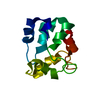
| |||||||||
|---|---|---|---|---|---|---|---|---|---|---|
| 1 |
| |||||||||
| NMR ensembles |
|
- Components
Components
| #1: Protein | Mass: 12067.064 Da / Num. of mol.: 1 Source method: isolated from a genetically manipulated source Source: (gene. exp.)   |
|---|
-Experimental details
-Experiment
| Experiment | Method: SOLUTION NMR | ||||||||||||||||||||||||
|---|---|---|---|---|---|---|---|---|---|---|---|---|---|---|---|---|---|---|---|---|---|---|---|---|---|
| NMR experiment |
| ||||||||||||||||||||||||
| NMR details | Text: This structure was determined using: 1. distance restraints collected from 3D NOESY experiments, 2. dihedral angle restraints based on coupling constants (HNHA), and chemical shift data (CSI, ...Text: This structure was determined using: 1. distance restraints collected from 3D NOESY experiments, 2. dihedral angle restraints based on coupling constants (HNHA), and chemical shift data (CSI, TALOS), 3. hydrogen-bond restraints (collected from H-D exchange measurements), 4. 1H-15N residual dipolar couplings |
- Sample preparation
Sample preparation
| Details |
| |||||||||||||||
|---|---|---|---|---|---|---|---|---|---|---|---|---|---|---|---|---|
| Sample conditions | Ionic strength: 0.15 M NaCl, 0.01 M Mes / pH: 6 / Pressure: 1 atm / Temperature: 293 K |
-NMR measurement
| Radiation | Protocol: SINGLE WAVELENGTH / Monochromatic (M) / Laue (L): M |
|---|---|
| Radiation wavelength | Relative weight: 1 |
| NMR spectrometer | Type: Varian INOVA / Manufacturer: Varian / Model: INOVA / Field strength: 600 MHz |
- Processing
Processing
| NMR software |
| ||||||||||||||||||||||||||||
|---|---|---|---|---|---|---|---|---|---|---|---|---|---|---|---|---|---|---|---|---|---|---|---|---|---|---|---|---|---|
| Refinement | Method: simulated annealing using torsion angle molecular dynamics Software ordinal: 1 Details: The structures are based on a total of 2961 restraints: 2553 are NOE-derived distance constraints, 241 are dihedral angle restraints, 74 are distance restraints derived from putative ...Details: The structures are based on a total of 2961 restraints: 2553 are NOE-derived distance constraints, 241 are dihedral angle restraints, 74 are distance restraints derived from putative hydrogen bonds, and 93 are angle restraints based on residual dipolar couplings | ||||||||||||||||||||||||||||
| NMR representative | Selection criteria: closest to the average | ||||||||||||||||||||||||||||
| NMR ensemble | Conformer selection criteria: structures with the lowest energy Conformers calculated total number: 50 / Conformers submitted total number: 20 |
 Movie
Movie Controller
Controller



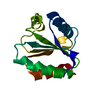

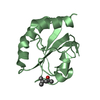
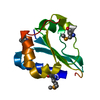
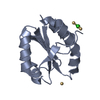



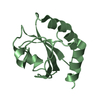
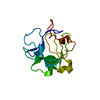
 PDBj
PDBj HSQC
HSQC